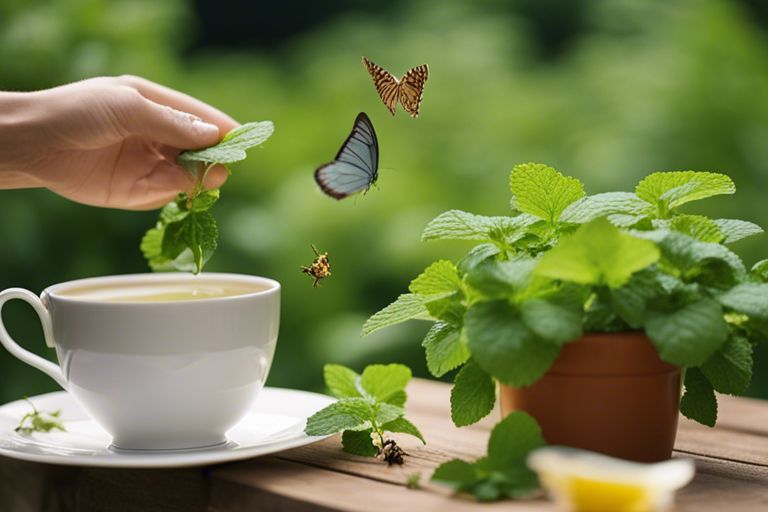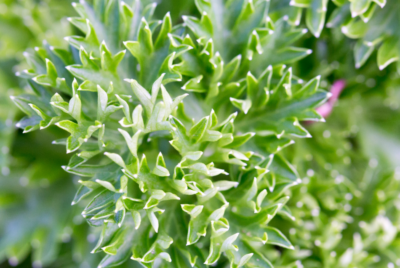Lemon Balm Tincture
Lemon Balm Tincture
Most known for its calming and uplifting properties, Lemon Balm is a versatile herb that can benefit your daily routine in many ways. From improving sleep quality to reducing anxiety and boosting cognitive function, this herb offers a wide range of health benefits. Whether you choose to enjoy it in a soothing tea, refreshing infused water, or as an essential oil, incorporating Lemon Balm into your daily regimen can have a positive impact on your overall well-being. Discover the various ways you can incorporate this powerful herb into your lifestyle and experience its beneficial effects firsthand.
Key Takeaways:
- Calming properties: Lemon balm can help reduce stress and anxiety, promoting a sense of calmness and relaxation.
- Improving sleep: Incorporating lemon balm into your routine can aid in improving sleep quality and combating insomnia.
- Easy to use: Lemon balm can be consumed in various forms such as tea, capsules, or essential oils, making it convenient to add to your daily routine.
1. Relaxation and stress relief.
2. Improve sleep quality.
3. Boost cognitive function.
4. Antioxidant and anti-inflammatory properties.
5. Ease digestive discomfort.
6. Can be used in teas, tinctures, or essential oils.
Starting Your Lemon Balm Journey
Obviously, you’ve heard about the amazing benefits of lemon balm and you’re ready to start incorporating it into your daily routine. Whether you want to grow your own plant or find quality products, there are several ways to begin your lemon balm journey.
Growing Your Own Lemon Balm Plant
Starting your own lemon balm plant can be a rewarding experience. Lemon balm is a hardy herb that grows well in containers or directly in your garden. By planting lemon balm, you’ll have fresh leaves to harvest for teas, tinctures, or to simply enjoy the calming scent.
For best results, plant lemon balm in well-drained soil and place it in a sunny location. Regular watering and occasional pruning will help your plant thrive. Before you know it, you’ll have a flourishing lemon balm plant right at your fingertips.
Finding Quality Lemon Balm Products
To incorporate lemon balm into your routine quickly, consider finding quality products that contain this powerful herb. Look for organic and ethically sourced lemon balm teas, tinctures, or essential oils. These products can provide a convenient way to enjoy the benefits of lemon balm without the need to grow your own plant.
To ensure you’re getting the best quality lemon balm products, read reviews, check for certifications, and opt for reputable brands. For instance, look for products that are third-party tested to guarantee purity and potency. By choosing high-quality products, you can maximize the benefits of lemon balm in your daily routine.
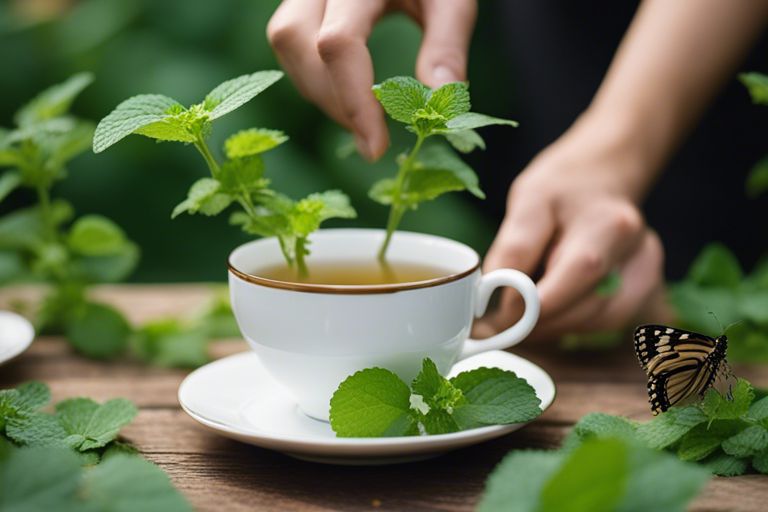
Everyday Uses for Lemon Balm
Despite its humble appearance, lemon balm is a powerhouse herb that can enhance your daily routine in a variety of ways. From soothing teas to flavorful recipes, incorporating lemon balm into your life can bring a burst of freshness and positivity.
Sipping on Lemon Balm: Teas and Tinctures
Balm tea is a popular way to enjoy the calming and uplifting benefits of lemon balm. Simply steep a handful of fresh leaves in hot water for a few minutes, then sweeten with honey for a delightful herbal infusion. For a more potent dose, consider trying lemon balm tinctures, which can be easily added to your favorite beverages for a quick pick-me-up.
Lemon Balm in Cooking: Recipes for Refreshment
An exciting way to incorporate lemon balm into your routine is by using it in cooking. This versatile herb adds a bright, citrusy flavor to both sweet and savory dishes. Try adding chopped lemon balm leaves to salads, pasta dishes, or desserts for a refreshing twist that will tantalize your taste buds.
Teas and tinctures aren’t the only ways to enjoy the benefits of lemon balm – incorporating this herb into your cooking can elevate your meals to new heights. Whether you’re baking a zesty lemon balm cake or sprinkling fresh leaves over grilled fish, the possibilities are endless when it comes to cooking with this versatile herb.
Lemon Balm Tincture Recipe
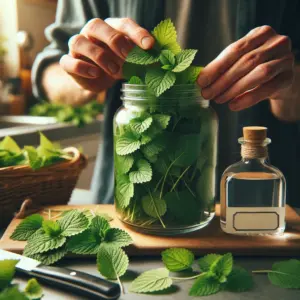
Ingredients:
- Fresh lemon balm leaves (enough to fill a quart-sized jar when chopped)
- High-proof alcohol (such as vodka or grain alcohol) enough to cover the leaves
- A quart-sized glass jar with a tight-fitting lid
Instructions:
-
Prepare the Lemon Balm: Begin by carefully washing your lemon balm leaves to remove any dirt or debris. Pat them dry with a clean towel.
- Chop the Leaves: Coarsely chop the lemon balm leaves to increase the surface area for the tincture and place them in the glass jar.
-
Add Alcohol: Pour the high-proof alcohol over the chopped leaves until the jar is nearly full, making sure that the leaves are completely submerged to prevent mold.
- Seal and Store: Tightly seal the jar with its lid. Label the jar with the date and contents. Store the jar in a cool, dark place, such as a cupboard or pantry.
-
Shake Daily: Shake the jar at least once a day to help the extraction process.
- Wait: Allow the mixture to infuse for 4 to 6 weeks. The longer it sits, the stronger your tincture will be.
-
Strain the Tincture: After the infusion period is over, strain the liquid through a cheesecloth or fine-mesh strainer into another clean jar or bottles. Squeeze or press the leaves to extract as much liquid as possible.
- Bottle It Up: Transfer the strained tincture into dropper bottles for easy use. Label the bottles with the date and contents.
-
Usage: To use, start with a small amount, such as 1-2 milliliters (which is about 30-60 drops), and see how you respond before increasing the dosage. The tincture can be taken directly under the tongue or added to a small amount of water or tea.
- Storage: Store your tincture in a cool, dark place. The alcohol preserves the tincture, giving it a shelf life of several years.
Remember, when making tinctures, it’s important to use herbs that are free from pesticides and other contaminants. Always consult with a healthcare provider before starting any new herbal regimen, especially if you are pregnant, nursing, or taking other medications.
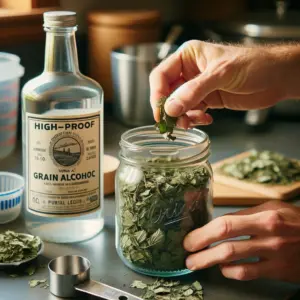
Lemon Balm Tincture Recipe with Dried Leaves
Ingredients:
-
1 cup dried lemon balm leaves
-
2 cups high-proof alcohol (such as vodka or grain alcohol, at least 80 proof)
-
A pint-sized glass jar with a tight-fitting lid
Instructions:
- Fill the Jar: Place the dried lemon balm leaves into the glass jar. The dried leaves should fill the jar about halfway to three-quarters.
-
Add Alcohol: Pour the high-proof alcohol over the dried leaves. Ensure that the leaves are completely submerged to prevent potential molding and to maximize the extraction of the lemon balm’s beneficial properties. Fill the jar to within an inch of the top.
- Seal and Label: Tightly seal the jar with its lid. Label the jar with the date you made the tincture and the ingredients you’ve used.
-
Store: Keep the jar in a cool, dark place like a cupboard or closet. The darkness and stable temperature will help to maintain the tincture’s potency.
- Shake Regularly: Shake the jar vigorously once every day. This agitation helps to extract the active compounds from the lemon balm leaves into the alcohol.
-
Steep: Allow the tincture to steep for 4 to 6 weeks. The steeping time can vary depending on personal preference for strength.
- Strain: After the steeping period, strain the tincture through a fine-mesh sieve or cheesecloth into another clean glass jar or bottle. Compress the leaves to extract as much liquid as possible.
-
Bottle: Transfer the strained liquid into dark glass dropper bottles for storage. Label these bottles with the contents and date.
- Usage: Typical use of a tincture is about 1-2 milliliters (approximately 30-60 drops) taken 2-3 times per day, or as directed by a healthcare provider. You can take the tincture directly under the tongue or dilute it in a little water or juice.
-
Storage: Keep your finished tincture in a cool, dark place. The high alcohol content will preserve the tincture for up to several years.
Note: When working with alcohol and dried herbs, it’s important to ensure proper ventilation and to be aware of potential interactions with medications. Always consult with a healthcare provider before beginning any herbal supplement, particularly if you are pregnant, nursing, or taking medications.
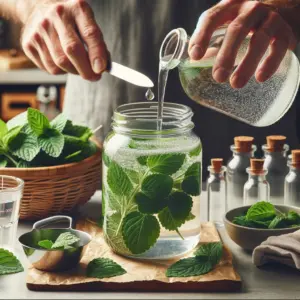
Balm for Mind and Body
After a long and stressful day, it’s essential to take care of both your mind and body. Incorporating lemon balm into your routine can have incredible benefits for your overall well-being.
Soothing Stress with Lemon Balm
Lemon balm, also known as Melissa officinalis, is a herb that has been used for centuries to calm nerves and promote relaxation. The natural compounds in lemon balm have anti-anxiety effects that can help reduce stress levels and improve mood.
Whether you prefer to enjoy a cup of lemon balm tea before bed or incorporate lemon balm essential oil into your aromatherapy routine, this versatile herb can be a powerful ally in your journey to finding calm and peace amidst the chaos of daily life.
Lemon Balm as a Skincare Ingredient
Any skincare enthusiast knows the importance of using all-natural and gentle ingredients on their skin. Lemon balm offers a range of benefits for the skin, including soothing irritation, reducing inflammation, and promoting a healthy complexion.
Lemon balm can be infused into facial cleansers, toners, and moisturizers to help revitalize and rejuvenate the skin. Its antioxidant properties also make it a great ingredient for combatting signs of aging and maintaining youthful skin.
Summing up
By incorporating lemon balm into your routine, you can enjoy its numerous health benefits, from reducing anxiety and stress to improving sleep and digestion. You choose whether to brew a soothing cup of lemon balm tea before bed, or add some fresh leaves to your salads and dishes. Or, you can enjoy the calming effects of lemon balm essential oil, or lemon tincture. This versatile herb is a great addition to your daily self-care routine. So why not give lemon balm a try and see how it can positively impact your overall wellbeing.
FAQ
Q: What is lemon balm?
A: Lemon balm is a herb from the mint family that has a lemony scent and flavor.
Q: How can I incorporate lemon balm into my routine?
A: You can incorporate lemon balm into your routine by making lemon balm tea, using it in cooking, or using lemon balm essential oil for aromatherapy.
Q: What are the benefits of using lemon balm?
A: Lemon balm has been known to help reduce stress and anxiety, improve sleep quality, and aid in digestion.
Q: Are there any side effects of using lemon balm?
A: Lemon balm is generally safe for most people when used in appropriate amounts, but excessive consumption may cause drowsiness or skin irritation in some individuals.
Q: Where can I buy lemon balm products?
A: Lemon balm products such as teas, essential oils, and supplements can be found at health food stores, online retailers, or local farmers markets.
